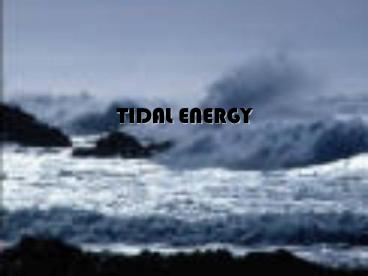TIDAL ENERGY INTRO Tidal energy is renewable and such PowerPoint PPT Presentation
1 / 20
Title: TIDAL ENERGY INTRO Tidal energy is renewable and such
1
TIDAL ENERGY
2
(No Transcript)
3
INTRO
- Tidal energy is renewable and such technology is
very important todays world where global warning
is becoming more and more of an issue.
4
TIDES
- Tidal action is caused by the gravitational pull
of the moon and sun upon the Earth as it rotates. - The movements of these bodies cause the surface
of the oceans to be raised and lowered depending
on their cycles. - It is because of these complex cycles that the
amount of energy retainable from the ocean varies
with location and time. - An advantage of tidal energy is that the amount
of electricity retainable is very predictable and
dependable.
5
TIDAL ENERGY
- The basic concept of tidal energy is to capture
the potential energy of the raising and lowering
of the tides. - The main advantage of tidal energy is that is it
is renewable and dependable.
6
HISTORY
- On a small scale, tidal power has been used
throughout the history of mankind. - In the Middle Ages, tide mills were common along
the coast of Western Europe. - It wasnt until the 20th Century that tidal
power was considered as an alternative to the
combustion of fossil fuels. - The construction of the French Barrage across the
Rance estuary
7
TIDE MILLS
8
THE TECHNICAL SIDE
- Traditionally generating tidal energy involves
constructing a dam wall across an opening of a
tidal basin. - The dam wall has gates, which open to allow the
water to come in as the tide rises. This happens
at great pressure and turns the turbines to
create electricity. - The same process is then repeated when the water
is let out back into the back into the ocean. - This happens every high tide, that is why it is
important to find a spot where the difference
between low and high tide is significant.
9
(No Transcript)
10
(No Transcript)
11
ADVANTAGES
- Water is a free resource
- No Pollution
- Is produced 24 hours a day all year round.
- Peak output coincides with peak energy demand.
- It is 80 efficient, where as coal is only 30
- It renewable.
12
DISADVANTAGES
- Tidal energy is not yet economically feasible.
- There are problems with the transportation of
electricity once it has been produced. - The technology is still being developed
- Non renewable sources of energy are preferred
because they have already been set up.
13
ECONOMICS
- Tidal energy is not cost competitive because it
is generally not commercially available. - When selecting a spot to set up a tidal energy
station it is important to make sure that it will
be economically feasible. - To set up a tidal facility with an average annual
output of 1050 MW would cost about 1.2 billion
dollars, not including maintenance and running
costs. - This is far more expensive than coal and oil.
14
WHAT ABOUT AUSTRALIA?
- The potential for tidal energy is very high in
North-Western Australia because the tidal ranges
are among the highest in the world. - The coast line there has several inlets and bays
that are promising sites. - These include the Walcott Inlet, Secure Bay and
St Georges Basin. - In the late 1990s, Tidal Energy Australia
proposed a project for Doctors Creek near the
Kimberly town of Derby.
15
- The advantages of this design was that is
provided energy around the clock. - One basin would hold high water and the other
would contain a low level of water. - A channel cut between the two would hold the
turbines for power generation. - At high tide water would be let into the basin
and at low tide it would be let out. - The plant would have had a capacity to produce
48MW and would have been the second largest in
the world and the only one to provide a
continuous output. - There was great community support in Derby but
after much debate the government decided that
attaining energy from fossil fuel was the
preference. - There is still the potential for such projects in
the future.
16
(No Transcript)
17
ENVIRONMENTAL IMPACTS
- Tidal energy is renewable, so therefore it
produces no harmful emissions and does not damage
the environment in that way. - However, there is little known about the effects
of controlling water levels on aquatic
ecosystems. - Unfortunately, the best way to research this is
though trial and that is a risk in itself.
18
FUTURE?
- In a society with increasing energy needs, it is
becoming more and more important to have
alternative sources of power to keep up with the
ever growing energy demand. - The capacity of tidal energy exceeds that of coal
and oil and is renewable. - The Department of Energy has shown great
enthusiasm in regards to tidal power as the
perfect energy source for the future.
19
BIBLIOGRAPHY
- TIDAL ENERGY
- http//europa.eu.int/comm/energy_transport/
atlas/htmlu/tidalover.html - Ocean Energy
- http//www.energy.ca.gov/development/oceane
nergy/ - TIDAL ENERGY
- http//www.uwec.edu/grossmzc/minotc.html
- TIDAL ENERGY
- http//www.geology.wisc.edu/pbrown/g410/tidal/ti
dal.html - TIDAL ENERGY
- http//www.eere.energy.gov/RE/ocean_tidal.html
- TIDAL ENERGY
- http//www.renewingindia.org/tid.html
20
THE END

